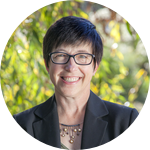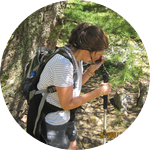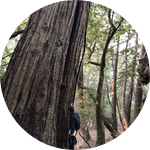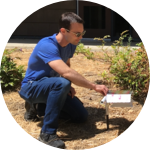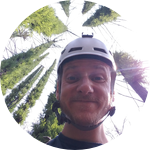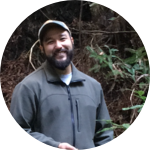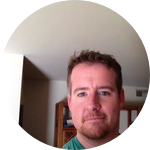About This Project
California climate models predict future high temperatures that reduce fog and threaten redwoods in hotter, drier parts of their range. Most tree models for climate change rely on models that focus on rainfall. Since redwoods use fog for water, rainfall-based models don't work for them.
To predict redwood population futures, we are creating a model that calculates redwood seedling stress tolerance, using fog and other microclimate factors not included in current models.
Ask the Scientists
Join The DiscussionWhat is the context of this research?
Species ranges around the world are predicted to shift due to climate change. Coast redwoods, the world's tallest tree species, are restricted to a narrow fog belt off the California coast, and in that belt their current range is a fraction of their historical range, due to human activities.
At mature redwood heights, water transport from roots is ineffective, so fog is a major source of moisture. Fog moisture is also taken up by seedlings. Research shows declining fog frequency in California. This is expected to impact seedling and population survival at extremes of the species range.
To evaluate the future of this keystone species, we are building a model that calculates redwood seedling stress tolerance, using fog and other microclimate factors not included in current models.
What is the significance of this project?
Most climate modeling for tree species future calculates climate envelopes, the range of locations a species survives in, based largely on climate water deficit or CWD. CWD-based modeling for redwoods shows population loss is most likely on fringes of the range where summer temperatures are high. But for redwoods, CWD misleads because it doesn't include water from fog.
Redwoods can re-sprout from stumps but these are just clones of the parent trees. Genetic diversity depends on seedlings. Our surveys show low seedling survival at the fringe sites, where climate models predict future loss of redwoods. If we can use our model to quantify the integrated factors that favor seedling survival, we may be able to understand which populations are most at risk, and act to save them.
What are the goals of the project?
We need to gather much more data in different fringe populations, looking at seedling distribution patterns and measuring microclimate variables such as temperature, relative humidity, canopy cover and light pattern.
We are currently using our microclimate data sets from summer 2018 to create a seedling "climate envelope" model that integrates the microclimate variables listed above, as well as fog effects and landscape topography.
After development of this first-stage model, we will test its predictions (following a method similar to this paper) with seedling transects and the more extensive microclimate data sets that will be collected in spring through fall 2019. Our refinements will be integrated into our on-going mapping, modeling, and testing.
Budget
We use Kestrel D1/D2 data loggers. All the data loggers collect temperature data (every 30 min); half our current set also assesses relative humidity. In summer 2018, data loggers were distributed at two field sites in Santa Clara and Sonoma counties. These dataloggers were purchased in part with department funds, part using a CA Native Plant Society grant, and part using personal funds.
The requested funds will be used to purchase two new sets of data loggers, all with capability to measure both temperature and relative humidity. In spring 2019 we plan to expand to two more sites – one in Monterey county (in the southern extreme of the range) & the other in San Mateo county. This will enable our team to add sites, double our data collection, and test the model developed so far using data logger data and seedling transects.
Stretch goal: student mileage to field sites. We can do more surveys and collect more data! See the lab note on this...
Endorsed by
 Project Timeline
Project Timeline
From January to March we are working on data crunching and model development, as well as training new team members, renewing permits, and such. In January and February we will be doing seedling transects and preparing for the data logger deployment and field season - radshield construction, new batteries, data logger configuration and testing.
Jan 31, 2019
Project Launched
Feb 08, 2019
Construct new set of radshields for new dataloggers
Feb 15, 2019
Film a demo for lab notes for backers of why and how to build a radshield
Mar 01, 2019
Order new dataloggers
Mar 15, 2019
Seedling transects and site surveys at least at Bear Creek, Pepperwood, and LH Big Creek (start in late January/early February)
Meet the Team
Team Bio
We are a collaborative group of biologists and biology students from a small community college, working to answer important questions in California ecology, focusing on the response of coast redwoods to climate change. Michelle and Jen have tree research backgrounds, but everyone on the team brings skills and passion to the project, from growing redwoods to mapping. Team members that have left WV College are still involved, because we are all committed to saving California's iconic biota.
Michelle Geary
I have a PhD in Plant Biology from UC Davis. My research focused on photosynthetic physiology of the evergreen tree tan-oak, studying function across years and seasons, across the species range - I'm fascinated by how plants deal with stress, especially stresses that change across time. I've been teaching plant bio at WV College since 2003; Jen and I started the redwood project in 2015. In 2017-2018, I took a research sabbatical to expand the project and refine a plan to integrate more research into undergrad education in and out of the classroom. I don't sleep enough but I love my students and my work.
Brandon Kong
I am a student at West Valley College, actively immersing myself in the fields of evolutionary biology and ecology. I have been working on refining our methods of collecting canopy data for this project - our preliminary work was presented at the WVC Earth Stewardship Symposium in the research poster Measuring Canopy Cover: Comparison of spherical densitometer measurements with CanopyApp and other smartphone-based options. I also have an obsession with herpetofauna.
Hugh Leonard
I’m starting my junior year at UC Santa Cruz as a biology major, focusing on plant biology and ecology. I’m part of the fog team, and one of the leaders of the Pepperwood fire response team. My Earth Stewardship Symposium poster Post-fire recovery of coast redwoods at extreme sites: Pepperwood Preserve case study outlined our plans for integrating the Pepperwood site into our study. Additionally I have begun to consider adding a minor in molecular biology as a way to gain a better understanding of how cellular uptake of available nutrients during development could affect redwood seedling establishment and population dynamics.
Nicholas J Bergeron
I’m in the first quarter of my junior year at UC Santa Cruz as an Ecology and Evolution major. I’m planning on a career in field ecology - I’m hoping to spend part of next summer in the Yukon - and I’m excited by the kinds of challenges that field research can offer. I’m up for anything from base jumping and rock climbing to diving into a patch of poison oak to retrieve a datalogger. I’ll be working with Jacob and Ethan to head the computer system building team.
Ethan De Groot
I am an undergraduate studying Botany and Administration of Justice at West Valley College. I'm the lead for most of the geospatial analysis that will be done to map and catalog the test sites, data logger positions, and relevant trees. As a precursor to my continued involvement with the redwood research group, my WVC Earth Stewardship Symposium poster Mapping Bear Creek Redwoods using ArcMap and ESRI Collector has set the ground work for future mapping. With continuous input from the research group, an accurate and modern map tailored to the ideal living conditions for redwood trees will be made to support our endeavors.
Joycelyn Ho
I’ve just started my junior year at UC Santa Cruz as a marine biology major. For the Earth Stewardship Symposium in 2018, as part of our fog team, I presented a research poster Analysis of Changes in Coastal Upwelling and the Future of Fog in California. I’m fascinated by the oceans and marine biology and I’m currently working on my research dive certificate.
Jennifer Mo
I hold an MS in Plant Biology from San Francisco State University. As a part of the Simonin Plant Ecophysiology Lab, I researched circadian rhythms of transpiration and stomatal conductance in several conifer species native to California, including coast redwood. I currently work as a field biologist in the Integrated Vegetation Field Operations Unit of the Santa Clara Valley Water District, where I monitor riparian sites for invasive plants and regeneration of native species.
John Adams
I’m a student at West Valley College, preparing to transfer to UC Santa Cruz in the fall of 2019 to major in environmental studies/biology and planning on doing graduate research in the coastal redwood forest. At the 2018 Earth Stewardship Symposium I presented research on Patterns of reproduction and regeneration in coast redwoods. When not working on the team project, including helping teach the team how to identify really tiny redwood seedlings, I am running a redwood growth experiment at home. I have always been enamored with the Coast Redwood, and am excited to be doing research that will help future generations!
Jacob Chung
I’m a student at West Valley College on my way to transfer to UC Santa Cruz, but I’m totally gonna keep working on this project even when I’m out in Santa Cruz. My major is Marine Biology but I have a love for all things nature, both terrestrial and marine. What really attracts me to this project is the idea that we are observing the effects of climate change and getting an idea of how we can help control or minimize these effects. I’ve done some scientific experiments before as well as built and maintenanced computers before.
Michelle Edingfield
I’m a new student at West Valley but have an Associate of Environmental Horticulture from Santa Barbara City College. My field experience includes restoration work on the Channel Islands, and preservation work in eastern Oregon assisting in surveying mixed-conifer forests to prevent over-logging. I’m returning to school now as an aspiring ecologist, interested in a career in forest conservation.
Additional Information
Project Backers
- 42Backers
- 124%Funded
- $1,899Total Donations
- $45.21Average Donation
